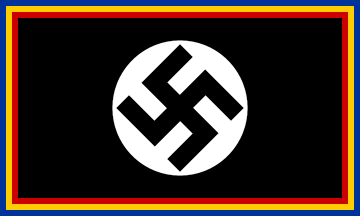 by Tomislav Todorovic, 2 December 2012
by Tomislav Todorovic, 2 December 2012
Last modified: 2013-06-01 by alex danes
Keywords: fascist | romania | iron guard |
Links: FOTW homepage |
search |
disclaimer and copyright |
write us |
mirrors
See also:
 by Tomislav Todorovic, 2 December 2012
by Tomislav Todorovic, 2 December 2012
This flag seems to have originally been that of the National Christian Defense League (Liga Apărării Naţional Creştine). That party was founded in 1923 as the successor of the National Christian Union (Uniunea Naţional Creştină), which was founded previous year by Alexandru C. Cuza, who also became the leader of new party1 2. Among its original members, there was also Corneliu Zelea Codreanu, who broke away in 1927 to found the Iron Guard1 2 3. From its predecessor, the National Christian Defense League inherited the use of swastika and added it to its new flag, whose design was described by Codreanu as follows3:
"The cloth of these flags was black - a sign of mourning; in the center a round white spot, signifying our hopes surrounded by the darkness they will have to conquer; in the center of the white, a swastika, the symbol of anti-Semitic struggle throughout the world; and all around the flag, a band of the Romanian tricolor - red, yellow and blue."While the design still cannot be precisely reconstructed, it may be supposed that the national colors were arranged so that blue be the outermost and red the innermost one, because the part of border along the hoist edge thus repeats the pattern of the national flag; this was applied here. The flag ratio is also a dubious element, having been borrowed here from the flag of the Third Reich. The shape of swastika can be reconstructed from the surviving documents related to the party, these revealing a symbol which seems not to differ much from the Nazi one, except that sometimes it is upright4 5, but may also be rotated for 45 degrees like the Nazi one; the latter orientation was also used by the National Christian Party (Partidul Naţional Creştin), founded in 1935 by merger of the National Christian Defense League and the National Agrarian Party (Partidul Naţional Agrar)6, in their electoral advertising material7, but also as a decorative patern of their uniforms8; these were introduced after the 1935 merger and were modelled after those of the Iron Guard, the main difference being in the shirts, which were blue instead of green9.
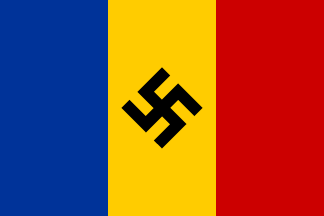 by Tomislav Todorovic, 2 December 2012
by Tomislav Todorovic, 2 December 2012
The black flag was abandoned some time after the 1927 in favor of the
national tricolor with a black swastika in the center. While the swastika is said there to be "thinner" than on the Nazi flag
("as if drawn in pencil"), the surviving documents related to the
party4 5 reveal a symbol which does not differ much from the Nazi
one, and the same is true about the documents related to the National
Christian Party7 8, which inherited the use of both the flag and
the swastika alone from the National Christian Defense League. This is
why the swastika is reconstructed here as identical to the Nazi one on
both flags. Regarding its orientation, although an upright form seems
to have been used in Romania more that in Germany, the use of the
symbol as an anti-Semitic one (see words of C. Z. Codreanu above)
reveals that it must have been borrowed from the Nazis as such, so
showing it as it was shown on the Nazi flag seems to be a reasonable
solution for the reconstruction.
Tomislav Todorovic, 2 December 2012
Sources:
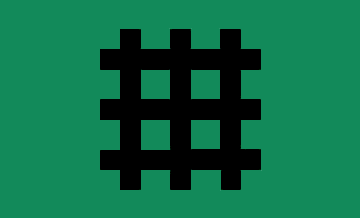 by Dan Anton Dima, 15 May 2005
by Dan Anton Dima, 15 May 2005
The flag I know of should be plain green - of a very "cold" hue - standing for freshness and purity (apparently); the color also featured on their uniforms. The triple cross is, most likely, black - as should be consistent with black-and-white photos in historical magazines. It could also be white, but not on the images I've seen. In fact, on the whole, it doesn't really matter. The Iron Guard did not favor a specific pattern, as long as it included the cross. I have also seen instances where it has a generic Nazi feel, but I couldn't tell whether the basic color was green(ish) or just plain red. There, the symbol was definitely black. It should be noted that, before and after being in power, the Guard extensively used the Romanian symbols, and it almost never did unify political and national symbols. Almost never! as I am very sure a version of the national flag with the triple cross was carried on some parades in the 30s and 40s. The symbol, which is always simple (it has no "serifs" like the FSU one, and does not have lengthened ends), is called, rather whimsically, "The Archangel Michael's Cross". In fact, it stands for prison bars and is (no connection to jail!) an ever-present style of Romanian votive wooden crosses by the roadside. Prison was where the movement's founder, Corneliu Zelea Codreanu, wrote his "Mein Kampf". He claimed he was inspired by an icon depicting the Archangel, as an "almost living presence".
There are surviving groups that evoke the Iron Guard legacy. One is simply
called "The Legionnaire Movement", and uses the black triple cross symbol
without associating it with any flag - they use a simple Romanian flag in
parallel. The symbol is in defiance of Romanian law, but they have a way of
being discreet. On the other hand, "The New Right", which could be a
splinter-group or the official voice, uses cold-green (almost bluish) or black
flags, with a white Celtic Cross, which is
sometimes outlined in the main color of the flag, marked with a contour of white
again.
Dan Anton Dima, 15 May 2005
A short glimpse into Iron Guard history. First of all, it should be noted
that, out of the many names the movement had, Romanians tend to prefer not
"guardians" or "Iron Guardsmen", but "legionari", "legionnaires" ("the
legionnaires" is, in Romanian, "legionarii"). The first name of the group was "Legiunea
Arhanghelului Mihail" - "The Legion of the Archangel Michael"- it also went
through "[The] Everything for the Country [Party]" in the 1930s, when it ran in
elections; "Miţcarea Legionară" - "The Legionnaire Movement" is the generic
term. Codreanu was, in his Iaţi University years - ca. 1920, a member of an
anti-Semitic party called "The National-Christian Defense League". He made
himself known for supporting a "numerus clausus" (restricted percentage) for
Jews wishing to attend University and for breaking up communist and
social-democratic rallies in the city. The League itself was a primitive
political group, which could act with extreme violence. Its leader, a certain
A.C.Cuza (not to be mistaken for XIXth century Prince Alexandru Cuza), claimed
to have "invented" the swastika back in 1918-19, during the time when it was a
very obscure, but certainly anti-Jewish symbol (the party had Romanian flags
with the black crooked-cross on them, although this was slightly "thinner", as
if drawn in pencil). Codreanu's philosophy was somewhat complex, or, in any
case, original. He founded the embryonic splinter-group ca. 1926 with a message
advocating Eastern Orthodox awakening, and an economical agenda of populist
persuasion (they meant to extend individually-owned plots of land to all the
land available!) and, sometimes, of socialist intent. The main reason for his
anti-Semitism was a medieval-Christian attitude, mainly suspicion and punishment
for "the killers of Jesus". His time in jail had happened after he himself
killed the prefect for Iaţi county in 1923 - it must be said, however, that
Codreanu was brutalized by the police, prior to that. The movement added death-
and persecution-defying attitudes to its aesthetics, and a will to defy each
political attitude in the establishment (Codreanu was at odds with fellow
fascists). It went on to gather an ever-growing following, uniting chunks of the
social spectrum, from members of the - not very dominant - aristocracy to large
groups of peasants. The movement took part in the Spanish Civil War, and they
had two prominent victims, both close two Codreanu, in the battle of Majadahonda.
The Leader was thought to be extremely charismatic: when he was banned from
talking at electoral meetings, he kept on being convincing by just smiling. The
end of him came in 1938, when he was assassinated after the Guard started its
conflict with King Carol (Charles) II. The King thought he could establish a
fascist regime, and tried to. This implied banning all parties, with the
legionnaires either surrendering (for Carol to lead the party) or dissolving. A
campaign of assassinations ensued (it has always been a favorite of the Guard -
they formed tens of death squads throughout their history), and it was still
undecided by 1940: even though they had killed a prime-minister, they were
decimated. In 1940, however, the King yielded power. This had nothing to do with
the political battle: Romania, tied to the UK and France, was left without cover
in front of the "New Order". Through the German-Soviet pact, it lost Bessarabia
and northern Bukowina. The Germans and Italians backed Hungary's request for
northern Transylvania. Thus, Romania lost a huge territory, without having gone
to war, in a couple of months. Carol left, and a new government took over. It
was officially a "crisis" government, but it became the building block of the
"National-Legionnaire State": Mihai I was a ceremonial king, Horia Sima - new
leader of the Guard/Legion - was an important political figure, and General
(later Marshall) Antonescu was "Leader of the State". From the very beginning,
Legion and Army were hardly reconcilable. They both, however, could agree on
politics of persecution and murder, mainly of Jews and Gipsies. In Feb. 1941,
tired of sharing power with a group that he deemed disorderly and fanatical,
Antonescu turned against his partners. Significantly, he was backed by Hitler,
who enjoyed a good communication with the General - add to this that he needed
Romanian oil and military backing for the Russian campaign which was meant to
start. The days of the Rebellion - as the Legion response is known -bloody, with
over 400 civilians killed. The more notable legionnaires left for Germany, and
they were detained in (the more acceptable parts of) the concentration camps:
they were taken out to form an exile government after the fall of Antonescu in
the pro-Allied coup (Aug. 1944), and fought for Hitler until the very end. They
took refuge in Spain and Portugal, and directed an anti-communist propaganda
service, without much success (as they were, of course, generally discredited).
Dan Anton Dima, 15 May 2005
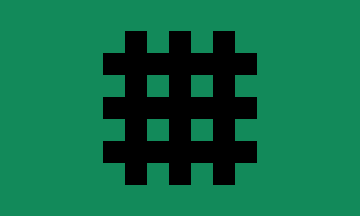 image
by Tomislav Todorovic and Mladen Mijatov, 17 June 2006
image
by Tomislav Todorovic and Mladen Mijatov, 17 June 2006
All information included in this contribution are presented for vexillological
purposes only. The political attitudes of the users of the described flags do
not represent those of the contributor.
In May 2001, I discovered via the Google some Web pages about the Iron Guard,
which no longer exist, where was written that the black grid symbol was adopted
by the movement in 1938 as the symbol of martyrdom of their founder C. Z.
Codreanu, who had previously been killed in an alleged attempt of escape from
the prison (nowadays generally considered as a fabrication covering the murder -
this might be believed in, as that was an anti-Fascist site). One of those pages
contained black and white photos from some rallies of the Iron Guard, with flags
charged with the black grid on dark field (colour not described, but it must
have been green). The distances between the bars forming the grid were equal to
their width, so the symbol looked as if it was composed of small squares. The
grid symbol with the same form was also appearing on other Web pages which no
longer exist, in 2001 and later.
The image above is the reconstruction of the described flag of the Iron Guard.
The image is partly based (the field colour) on the image at the top of this
page, which was created by Dan Anton Dima.
Tomislav Todorovic, 17 June 2006
According to Todor Kuljic, "Fascism", p. 97, the Iron Guard had originally used the swastika symbol; after giving the founding date of the party (1927), the book says: "The black flag of the movement with the swastika in a white circle soon became well-known in Romania." No other details about this flag are given, but the symbol must have been borrowed from the National-Christian Defense League, whose member Codreanu originally was. The flag must have been withdrawn from use by 1938, as flags with the black grid were introduced then; the source says nothing about that.
Editor's note: see above.
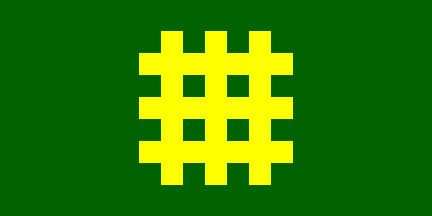 image
by Tomislav Todorovic and Mladen Mijatov, 17 June 2006
image
by Tomislav Todorovic and Mladen Mijatov, 17 June 2006
In May 2001, together with the pages about the Iron Guard described above, I
discovered the site of a modern organization which used that name. The site was
entirely in Romanian, but it contained the photos showing the members with the
flags of the organization, which was dark green (FOTW colour V++ or a bit
darker) with the golden grid - yellow, in fact, as one of the photos showed the
flag on the wall, together with the national flag of Romania, and the grid was
obviously in the same shade of colour as the yellow field of Romanian flag. The
users of this flag probably thought that the black colour of the grid, as the
symbol of mourning, was no longer convenient for them, so they replaced it with
the gold/yellow, which might better represent their glorification of their
killed predecessors (and is also one of their national colours). The form of the
grid was the same as on the previously described flag - as if being composed of
small squares. The said site seems to have been closed shortly afterwards and
has not reappeared ever again, so this organization was probably either
dissolved or forced into hiding.
Tomislav Todorovic, 17 June 2006
Source:
Kuljić, Todor: Fašizam
Belgrade: Nolit, 1987, (2nd revised and expanded edition)
ISBN 86-19-01480-3